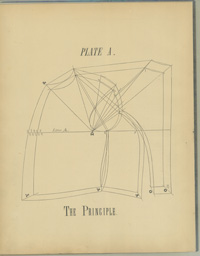 |
||||||
2. The Guidelines: Manuals, Patterns, Graphs & Charts
|
Special Collections has an exceptional variety of reference books, instruction manuals, paper patterns for sewing, charted needlepoint designs, and pattern books for weaving. These technical drawings explore the graphic dimension of the artful line. Among a fantastic array of reference books published on subjects as diverse as ecclesiastical costume and wigmaking, we find a rare supplement from Diderot’s Encyclopedia, the18th-century compendium to all the arts and sciences. Instructional guides with graphic diagrams such as A Practical Guide of the Tailor’s Cutting-room (1848) and The Complete Grading System (1883) were essential for the professional tailor. For a gentleman to appear “correctly” dressed, his tailor had to follow sartorial rules and standards of fit. As one tailor noted in 1865, ‘Anyone who does not want to dress merely comfortably must absolutely have a tailor to clothe him according to the arbitrary prescriptions of fashion, but above all so that he may be worthy of the society in which he moves and seeks success…delicate nuances [of dress] cannot be learned by social experience alone. Experience and professional knowledge are needed to acquire them.” As the tailor helped to define ideal manhood, the domestic magazine contributed to the process of defining femininity. In the 19th century, embroidery and sewing patterns offered both “amusement and instruction.” As Margaret Beetham put it in A Magazine of Her Own, the paper pattern bridged the gap “between the reader as ‘household manager’ on the one hand and as fashionable lady on the other.” Samuel Beeton’s Englishwoman’s Domestic Magazine of 1860 was the first periodical to include sewing patterns along with fashion illustrations. Shortly thereafter, sewing machines were marketed for domestic use. In addition to Special Collections’ assorted sewing patterns, there are beautiful hand-rendered pattern books for weaving. Similar to musical notation, pattern drafting provides graphic instructions to create a weave. Threading, heddle tie-up and treadling sequences are illustrated in diagrams, and the draw-down is a charted design of the final textile pattern.
|
|||||
